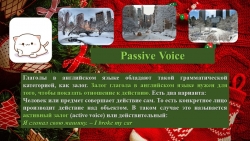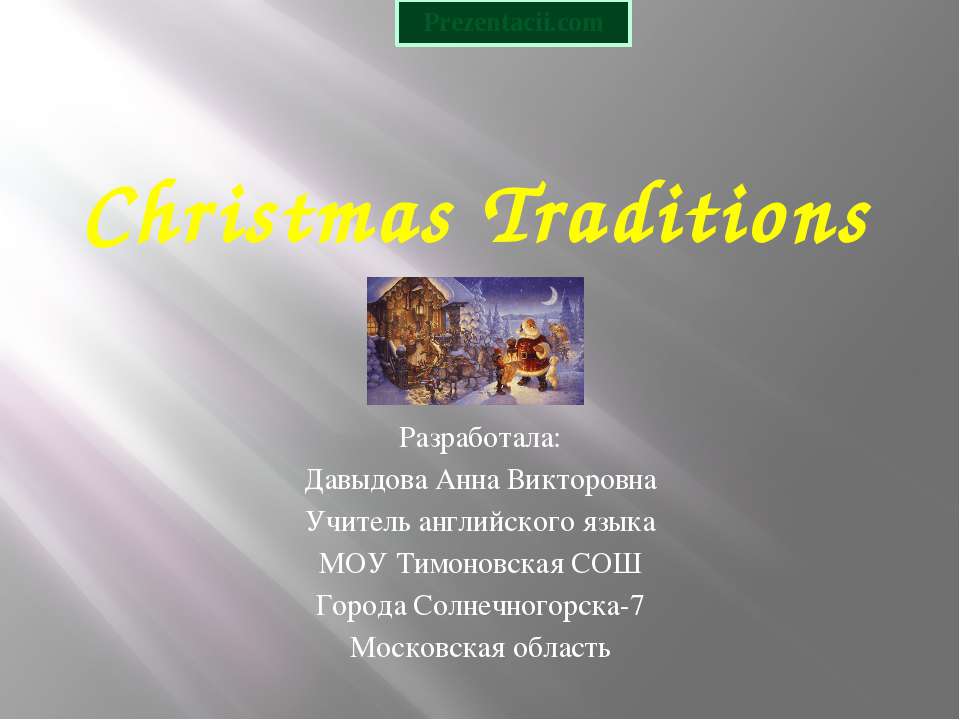Презентация на тему "Passive Voice" + 10 Christmas traditions

- Рубрика: Презентации / Другие презентации
- Просмотров: 80
Презентация для классов "Презентация на тему "Passive Voice" + 10 Christmas traditions" онлайн бесплатно на сайте электронных школьных презентаций uchebniki.org.ua
Passive Voice
Глаголы в английском языке обладают такой грамматической категорией, как залог. Залог глагола в английском языке нужен для того, чтобы показать отношение к действию. Есть два варианта:
Человек или предмет совершает действие сам. То есть конкретное лицо производит действие над объектом. В таком случае это называется активный залог (active voice) или действительный:
Я сломал свою машину. – I broke my car
Действие совершается непосредственно над объектом. То есть сам объект действие не совершает, а подвергается влиянию извне (причем объектом в предложении может быть и человек, и предмет). Такое явление носит название пассивный залог (passive voice) или страдательный.
Машина была сломана. – The car was broken
Для чего нужен залог
Перевод в пассивный залог хорош тем, что его можно использовать в тех случаях, когда не хочется обвинять кого-то конкретного, а обсудить ситуацию хочется. Пассивные конструкции также придают высказываниям более вежливый характер. Их часто используют в деловом общении и в различной документации.
Употребление пассивного залога необходимо при работе с правилами, инструкциями, законами в английском языке. Информация в подобных источниках подается объективно и независимо от личного мнения говорящего. Сообщать выводы от своего лица крайне нежелательно в таких случаях
Напомним, что главное отличие пассивного залога от активного в том, что здесь акцент на действии, которое совершается над объектом (а не самим объектом). Объектом может выступать человек или предмет.
Пассивный залог используется в конкретных случаях
Факт совершения действия гораздо важнее, чем его исполнитель.
The towels were not used yesterday. – Полотенцами вчера не пользовались (или Полотенца не были использованы вчера).
В этом примере подлежащее обозначает предмет (полотенца), который подвержен действию со стороны кого-либо (исполнитель нам неизвестен), а сам при этом ничего не выполняет. В данном случае факт того, что полотенцами не пользовались, куда важнее для говорящего, чем то, кто именно ими не воспользовался.
Мы не знаем, кто совершил действие
The bank was robbed. – Банк ограбили.
То есть что-то произошло, опять-таки важен сам факт произошедшего. Но в данном случае нам не то, чтобы не важно кто это сделал — мы просто не знаем.
Когда мы не хотим говорить, кто именно это сделал.
Например, если произошло что-то плохое, и мы не хотим никого обвинять.
The holiday is spoiled. – Праздник испорчен.
Tries
You’ll find a Christmas tree in most homes in the UK at this time of the year. Some people decorate the tree early (at the start of December), while others leave it until 24th. Typical things to put on a Christmas tree include fairy lights, baubles and tinsel. The origin of the Christmas tree goes back to 16th century Germany. Later, in 1841, German Prince Albert (Queen Victoria’s husband) brought the custom to England when he put up a Christmas tree at Windsor Castle to remind him of the ones he had as a child… and the tradition just grew from there.
Stockings
It’s typical for children to leave a stocking by the fireplace on 24th December. This is so “Santa” (aka the parents) can fill it with little gifts. Apparently, the tradition comes from Saint Nicholas (270-343 AD), who once threw some gold down the chimney of a poor man’s home. By chance, the gold fell into some stockings that had been left there to dry. Incidentally, St Nicholas is known as “Sinterklaas” in the Netherlands, which is where the name Santa Claus comes from.
Carols
Carols are Christmas songs like the world-famous Silent Night. Many traditional English carols come from around the 18th and 19th centuries, such as God Rest Ye Merry Gentlemen. Other more modern Christmas songs include Rudolph the Red-Nosed Reindeer, Last Christmas (by Wham) and Bing Crosby’s White Christmas. In towns and cities all over the UK, people sing carols in the streets or town squares. Some even sing at home with the family; or they go “caroling”, which consists of going from house to house singing carols.
Calendars
It’s common to see Advent calendars in many homes during Christmas. These are little calendars with a Christmas image, and 24 little windows with the numbers 1 to 24 written on them in random order. The numbers represent the 24 days before Christmas Day (on 25th December). Behind each window, there’s a little chocolate and a picture such as a reindeer, snowman, present... The first advent calendars, like the ones we have today, appeared in Germany in the early 1900s.
Cards
Many people in the UK send Christmas cards. In fact, if you visit someone’s house during the Christmas period, it’s typical to see a display of cards sent by friends and family members. The tradition was
started by Sir Henry Cole (1808-1882) and artist John Horsley. Together, they created the first Christmas card in 1843 as a way of encouraging people to send more letters
and use the postal service. Cards can have a variety of images on them, including religious ones (such as the baby Jesus), wintery ones (like snowy trees), or fantasy ones (such as a snowman).
Turkeys
The star of many Christmas dinners (served any time from 2pm to 7pm) is a roast turkey. The first turkeys, which came from Mexico, were brought to England in the 16th century by Turkish merchants(which is where the name “turkey” comes from). King Henry VIII (1491-1547) was the first king to enjoy turkey for Christmas. For many years, the meat was too expensive for most households, but it became popular after turkey prices decreased in the 1950s.
Plants
It’s typical to decorate houses with plants at Christmas. Holly and ivy are evergreens, so they provide some colour during the dark months; and holly also has bright red berries. Another typical plant is mistletoe. It’s typical to hang it above a door, and the custom is to kiss under it. The tradition of decorating homes with these plants comes from pagan times. Back then, the plants were seen as a way to protect the home from evil spirits; they were also fertility symbols.
Crackers
Christmas Crackers are placed on the table for dinner. The idea is to open them with someone else. To do this, each person holds a thin piece of paper that goes through the middle of the cardboard cylinder inside the cracker. On the count of three both people pull on their end of the paper, and BANG, there’s a small explosion, which is caused by a tiny firework inside the cracker. On opening the cracker, you can find three things: a little present, a joke and a paper crown that you’re supposed to wear during the dinner. Christmas crackers were invented by confectioner Thomas Smith (1823-1869) in the 1840s as a way of selling more of his chocolates, which he placed inside crackers.
Mince pies
Mince pies are little cakes filled with mincemeat, which is a mixture of nuts, raisins and dried fruit, as well as spices like nutmeg and cinnamon. Mince pies originated from the 12th century when crusaders returned from the Holy Land with traditional spices and delicacies. Mince pies usually have a star on top, to represent the Christmas Star, which led people to baby Jesus in Bethlehem. The original mince pies had meat in them, but these days, they’re just sweet.
Puddings
A Christmas pudding is a cake with raisins, nuts and dried fruit. It’s like a fruitcake, except it’s steamed instead of being baked. Sometimes, a coin is hidden inside the Christmas pudding. The person who finds it will have good luck… and the money! Sometimes, brandy is poured over the pudding, which is lit as it’s taken to the table. The pudding can also be served with brandy butter, which is made from butter, sugar and brandy. The pudding has its origins in 15th century England.




























